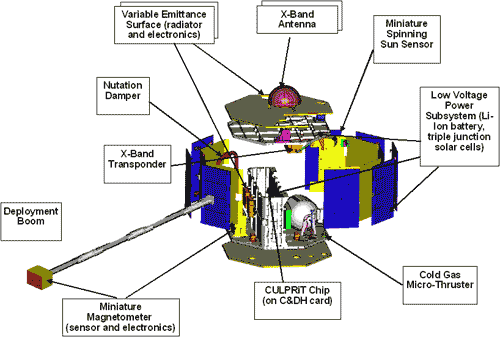|
 |
|
Enabling Technologies |
Space Technology 5 tested multiple technologies to support the success of future micro-sat missions. Each technology represents a breakthrough in performance, capability, or application in a new and unique manner.

|
ST5 micro-sat components.
|
Goddard Mission Services Evolution Center (GMSEC)
Automation components within the ground system.
Communications Components for Small Spacecraft
The X-Band Transponder Communications System was provided by AeroAstro. The transponder system is a miniaturized digital communications transponder. It provides coherent uplink-to-downlink operation that provides a ground-to-space command capability, space-to-ground telemetry capability, and a radio frequency tracking capability. The X-Band weighs approximately 1/12th as much and is 1/9th the volume of communications systems now used in other missions.
Results: Activated at spacecraft turn-on and operated well within their specification.
Evolved Antenna
A supercomputer using an artificial evolution algorithm designed a very tiny, highly unlikely looking, but highly promising communication antenna for the ST5 spacecraft.
Results: Operated well within specification.
Lithium-Ion Power System for Small Satellites
The Low-Voltage Power System uses a low-weight Li-Ion battery with triple junction solar cells that can store up to four times as much energy as their Ni-Cad counterparts. The Li-Ion rechargeable battery has a longer life and doesn't remember how much it has been discharged prior to recharging.
Ultra Low-Power Demonstration
The CULPRiT is a new type of microelectronic device that allows circuits to operate at 0.5 Volts. The technology will greatly reduce power consumption while achieving a radiation tolerance of ~100kRad total dose and latch-up immunity.
Results: Activated on all three spacecraft and operated without a flaw.
Variable Emittance Coatings for Thermal Control
The Variable Emittance Coatings, provided by Sensortex, Inc. and the Applied Physics Laboratory (APL), are used for thermal control and consist of an electrically tunable coating that can change properties, from absorbing heat when cool to reflecting or emitting heat when in the Sun. The Microelectromechanical System (MEMS) chip is part of this technology.
Results: Operated within specification.
Propulsion Systems Components
A miniature microthruster that provides fine attitude adjustments on the spacecraft. The Cold Gas Microthruster (CGMT) is a tiny electromechanical system designed by Marotta Scientific Controls, Inc. to provide fine attitude adjustments on each of the micro-sats. It uses 1/8th the power and weighs only half as much as attitude control systems being used in other missions.
Results: successfully maneuvered all three spacecraft, including both attitude and orbit maneuvers.
Other Technologies
-
Miniature magnetometer
Results: All three magnetometers operated well.
-
Miniature spinning sun sensor
Results: Operated well.
-
Spacecraft deployment mechanism
Results: Deployments were flawless.
-
Magnetometer deployment boom
Results: Deployments were nominal.
-
Nutation damper
Results: Performed within their specification.
|